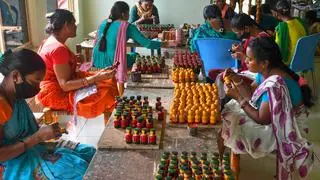The depreciation of the rupee vis-à-vis the dollar over the last three months has made India’s exports more competitive . The underlying optimism on fresh manufacturing orders, nonetheless, has been partly offset by rising input costs, primarily of fuel and commodities. Also, the current NBFC sector crisis may negate the possible gains arising as a result of US-China trade war.
However, one must appreciate the government for actively working towards resolving the issue and, at the same time, pushing the export promotion councils where India could have a comparative advantage.
Considering the scepticism over India’s macroeconomic stability, the recent PMI numbers emerge as a silver-lining for the country’s manufacturing outlook. An analysis by Acuité Ratings & Research (a SIDBI Associate) of the manufacturing PMI (Purchasing Managers Index) for India reveals that the index has remained over 51 for much of the last one year despite the monthly volatility that is typically seen in the PMI.
The index measures the overall sentiment of the manufacturing sector of an economy by incorporating views from a panel of purchasing managers; a figure of over 50 means business expansion.
PMI performance
Indian manufacturing, as per the survey and reflected in the PMI numbers, witnessed expansion in employment opportunities and new orders. Both new and overseas orders have been rising continuously — tenth month in a row.
This reflects improving sentiments in the manufacturing sector, and even among exporters, with regard to hiring plans and business outlook.
In Chart 1, what is of interest is the correlation between the manufacturing PMIs of India and China. China, the global manufacturing powerhouse, saw a sharp contraction in PMI to 50.8 during February 2018 and is yet to recover from that weak trend.

While comparing the overall performance of both India and China on a YTD (year to date) basis, India has been a consistently better performer over the past few months.
India’s YTD PMI for FY19 stands at 52 as against 50.8 in the same period last year. China, on the other hand, recorded a YTD PMI of 51.46 against 51.44 a year ago. This means that while Indian PMI gained almost 120 basis points (bps) since last year, the Chinese PMI rose by just two bps — almost stagnant, that is. This is may be due to the country’s ongoing trade war with the US.
Also, the expected US sanctions on imports from China and their impact on upcoming orders have weakened China’s business outlook.
This apart, Chinese exporters have also witnessed intensifying cost pressures due to restructuring, environmental compliance and tighter fiscal policy.
Chart 2 shows the divergent trends in the growth of the manufacturing sector in China and India. While China recorded a manufacturing growth of 11 per cent in Q1 FY19 (normalised to Indian financial year standard), India expanded its manufacturing activity by 18 per cent.
Will it sustain?
What’s heartening is that the growth in India comes on top of a strong base of 13.5 per cent as compared to China’s 12.7 per cent in Q1 FY18. There is significant divergence since Q4 FY18 between the two nations when Chinese manufacturing growth was nearly 140 bps higher than that of India.
While it may be a bit premature to assess the situation at the ground level, preliminary analysis does reveal that China’s manufacturing sector has been negatively impacted by the ongoing trade tensions with the US. India may be the beneficiary of such trade conflict in the near term.
However, the sustainability of such a trend needs to be seen over the next few quarters.
In this context, input cost escalation and the inflationary pressures on the Indian manufacturing sector will be particularly important.
The writer is Chairman and Managing Director of SIDBI.







Comments
Comments have to be in English, and in full sentences. They cannot be abusive or personal. Please abide by our community guidelines for posting your comments.
We have migrated to a new commenting platform. If you are already a registered user of TheHindu Businessline and logged in, you may continue to engage with our articles. If you do not have an account please register and login to post comments. Users can access their older comments by logging into their accounts on Vuukle.